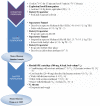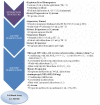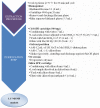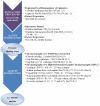Update on methodologies available for ciguatoxin determination: perspectives to confront the onset of ciguatera fish poisoning in Europe
- PMID: 20631873
- PMCID: PMC2901828
- DOI: 10.3390/md8061838
Update on methodologies available for ciguatoxin determination: perspectives to confront the onset of ciguatera fish poisoning in Europe
Abstract
Ciguatera fish poisoning (CFP) occurs mainly when humans ingest finfish contaminated with ciguatoxins (CTXs). The complexity and variability of such toxins have made it difficult to develop reliable methods to routinely monitor CFP with specificity and sensitivity. This review aims to describe the methodologies available for CTX detection, including those based on the toxicological, biochemical, chemical, and pharmaceutical properties of CTXs. Selecting any of these methodological approaches for routine monitoring of ciguatera may be dependent upon the applicability of the method. However, identifying a reference validation method for CTXs is a critical and urgent issue, and is dependent upon the availability of certified CTX standards and the coordinated action of laboratories. Reports of CFP cases in European hospitals have been described in several countries, and are mostly due to travel to CFP endemic areas. Additionally, the recent detection of the CTX-producing tropical genus Gambierdiscus in the eastern Atlantic Ocean of the northern hemisphere and in the Mediterranean Sea, as well as the confirmation of CFP in the Canary Islands and possibly in Madeira, constitute other reasons to study the onset of CFP in Europe [1]. The question of the possible contribution of climate change to the distribution of toxin-producing microalgae and ciguateric fish is raised. The impact of ciguatera onset on European Union (EU) policies will be discussed with respect to EU regulations on marine toxins in seafood. Critical analysis and availability of methodologies for CTX determination is required for a rapid response to suspected CFP cases and to conduct sound CFP risk analysis.
Keywords: CFP; Europe; Gambierdiscus; ciguatera; ciguatoxin; detection methods; methods.
Figures









Similar articles
-
Ciguatera Fish Poisoning in the Caribbean Sea and Atlantic Ocean: Reconciling the Multiplicity of Ciguatoxins and Analytical Chemistry Approach for Public Health Safety.Toxins (Basel). 2023 Jul 10;15(7):453. doi: 10.3390/toxins15070453. Toxins (Basel). 2023. PMID: 37505722 Free PMC article. Review.
-
A 15-Year Retrospective Review of Ciguatera in the Madeira Islands (North-East Atlantic, Portugal).Toxins (Basel). 2023 Oct 27;15(11):630. doi: 10.3390/toxins15110630. Toxins (Basel). 2023. PMID: 37999493 Free PMC article. Review.
-
Ciguatera: recent advances but the risk remains.Int J Food Microbiol. 2000 Nov 1;61(2-3):91-125. doi: 10.1016/s0168-1605(00)00382-2. Int J Food Microbiol. 2000. PMID: 11078162 Review.
-
Development of a monoclonal antibody against the left wing of ciguatoxin CTX1B: thiol strategy and detection using a sandwich ELISA.Toxicon. 2012 Sep 1;60(3):348-57. doi: 10.1016/j.toxicon.2012.04.347. Epub 2012 May 7. Toxicon. 2012. PMID: 22575284
-
Contribution to the risk characterization of ciguatoxins: LOAEL estimated from eight ciguatera fish poisoning events in Guadeloupe (French West Indies).Environ Res. 2015 Nov;143(Pt B):100-8. doi: 10.1016/j.envres.2015.09.014. Epub 2015 Sep 26. Environ Res. 2015. PMID: 26409497
Cited by
-
Fluorescent Receptor Binding Assay for Detecting Ciguatoxins in Fish.PLoS One. 2016 Apr 13;11(4):e0153348. doi: 10.1371/journal.pone.0153348. eCollection 2016. PLoS One. 2016. PMID: 27073998 Free PMC article.
-
Algal ciguatoxin identified as source of ciguatera poisoning in the Caribbean.Chemosphere. 2023 Jul;330:138659. doi: 10.1016/j.chemosphere.2023.138659. Epub 2023 Apr 10. Chemosphere. 2023. PMID: 37044143 Free PMC article.
-
Revisiting the Neuroblastoma Cell-Based Assay (CBA-N2a) for the Improved Detection of Marine Toxins Active on Voltage Gated Sodium Channels (VGSCs).Toxins (Basel). 2020 Apr 27;12(5):281. doi: 10.3390/toxins12050281. Toxins (Basel). 2020. PMID: 32349302 Free PMC article.
-
Asynchrony of Gambierdiscus spp. Abundance and Toxicity in the U.S. Virgin Islands: Implications for Monitoring and Management of Ciguatera.Toxins (Basel). 2021 Jun 10;13(6):413. doi: 10.3390/toxins13060413. Toxins (Basel). 2021. PMID: 34200870 Free PMC article.
-
Does climate change increase the risk of marine toxins? Insights from changing seawater conditions.Arch Toxicol. 2024 Sep;98(9):2743-2762. doi: 10.1007/s00204-024-03784-5. Epub 2024 May 25. Arch Toxicol. 2024. PMID: 38795135 Review.
References
-
-
In the whole text, Europe is not understood as the political entity which includes overseas territories but as a continent (geographical definition).
-
-
- Yasumoto T. Chemistry, etiology, and food chain dynamics of marine toxins. Proc. Jpn. Acad., Ser. B. 2005;81:43–51.
-
- Lewis RJ. The changing face of ciguatera. Toxicon. 2001;39:97–106. - PubMed
-
- Bottein Dechraoui M-Y, Wang Z, Ramsdell JS. Optimization of ciguatoxin extraction method from blood for Pacific ciguatoxin (P-CTX-1) Toxicon. 2007;49:100–105. - PubMed
Publication types
MeSH terms
Substances
LinkOut - more resources
Full Text Sources
Other Literature Sources
Miscellaneous
